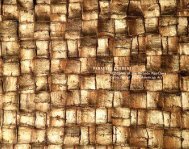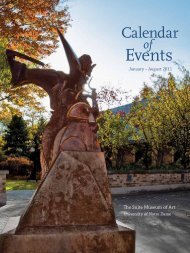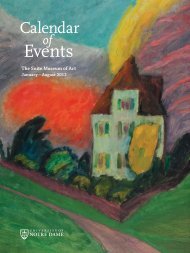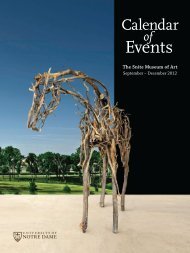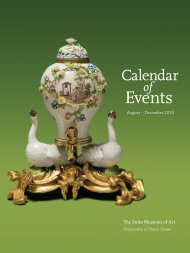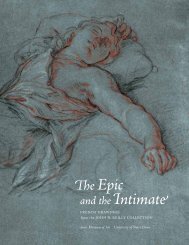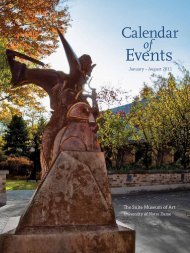HISTORY INTO ART AND ANTHROPOLOGY - Snite Museum of Art ...
HISTORY INTO ART AND ANTHROPOLOGY - Snite Museum of Art ...
HISTORY INTO ART AND ANTHROPOLOGY - Snite Museum of Art ...
Create successful ePaper yourself
Turn your PDF publications into a flip-book with our unique Google optimized e-Paper software.
or out <strong>of</strong> ammunition. Armed with a bow, White Swan could have fired from a<br />
distance, but instead he charged and struck his adversary with a short, featherdecorated<br />
lance before the enemy could use his pistol. Touching the enemy with<br />
an object held in one’s hand, whether a lance with a lethal point or a blunt staff,<br />
brought greater honor than firing from a distance. 14 The man he faces is surely an<br />
experienced and accomplished warrior, as shown by his accoutrements. To strike<br />
him at close range was indeed a coup worth recounting. Some details differ in other<br />
renditions <strong>of</strong> this event—the feathers on the lance, the clothing <strong>of</strong> the enemy—but<br />
the basic story <strong>of</strong> the weapons, the illustrious opponent, the charging red horse,<br />
and the lance-point encounter all remain consistent (fig. 11).<br />
The second <strong>of</strong>t-repeated scene shows White Swan riding down another eminent<br />
opponent, the warrior wearing the ermine-tail shirt, who is on foot. He may have<br />
fallen from his horse amid combat and become temporarily disoriented, unable to<br />
bring his pistol to bear. But he is not alone. His companion on the green horse has<br />
already fitted an arrow to his bow, prepared to defend his comrade. This time, White<br />
Swan shows himself striking his foe with a staff made for just such a purpose, an<br />
implement without a point known as a coup stick. As before, White Swan included<br />
different details in other versions <strong>of</strong> this scene, most <strong>of</strong>ten omitting the second<br />
enemy and focusing instead on the warrior he is striking. The design on the shield<br />
varies between pictures, as does the positioning <strong>of</strong> the figures. But he always shows<br />
the enemy’s shirt, pistol, and feather bonnet— as well as himself reaching eagerly<br />
with the coup stick. White Swan is depicted simply: wearing his usual green shirt,<br />
plume wafting from his head, mounted on his yellow warhorse. That he displays no<br />
arms other than the coup stick does not mean that he lacked them but that they<br />
were irrelevant to the event. He set them aside, racing forward in the thick <strong>of</strong> battle<br />
to be the first to strike this unhorsed enemy.<br />
White Swan painted some scenes only once, such as the picture on the Lindesmith<br />
muslin that depicts a moment during the Battle <strong>of</strong> the Little Big Horn. The key<br />
to time and place is the forked flag, or guidon, that White Swan carries; this was<br />
Custer’s personal insignia, designed for him by his wife. 15 Many pictures on other<br />
muslins and hides show White Swan carrying the same insignia, but nowhere else<br />
does he encounter a warrior with a shield or one riding a dappled red horse. In the<br />
scene on the Lindesmith muslin, White Swan, armed with a rifle, fires on an enemy<br />
armed with a lance. The encounter, while honorable, lacks the prestige <strong>of</strong> the coups<br />
noted above. His yellow horse has been shot in three places, as shown by streaming<br />
blood, and he himself is wounded in the leg. Among the Crow, to be wounded in<br />
battle was counted as a coup, as was having one’s horse shot from under its rider.<br />
Both were honored as indicators <strong>of</strong> close engagement and personal risk. 16 In this<br />
scene, White Swan gains honor not just because <strong>of</strong> what he inflicted on others but<br />
also because <strong>of</strong> what they inflicted on him. Although this particular encounter is<br />
not repeated in other imagery, all his pictures <strong>of</strong> the battle include at least one scene<br />
showing wounds he and his horse sustained. Wound insignia became part <strong>of</strong> his<br />
formal display <strong>of</strong> war honors. When White Swan posed for Burbank’s portrait <strong>of</strong><br />
him, he proudly displayed three feathers in his hair—representing the wounds he<br />
had received during that fight.<br />
The muslin Lindesmith acquired is probably one <strong>of</strong> White Swan’s earliest known<br />
paintings, and it vividly reflects indigenous Plains artistic concepts, which the artist<br />
modified somewhat over time as he produced more works for sale. The large, square<br />
format <strong>of</strong> this muslin is reminiscent <strong>of</strong> the size and shape <strong>of</strong> the painted buffalo<br />
hides used as robes or hung as draft screens inside tipis. All <strong>of</strong> White Swan’s other<br />
muslins are painted on single lengths <strong>of</strong> cloth, with a smaller surface and a very<br />
different format. Here, individual vignettes are loosely scattered across the surface,<br />
not evenly spaced; White Swan was more focused on communicating information<br />
than on spatial arrangement. His other works reflect greater attention to layout,<br />
although he continued presenting individual vignettes rather than attempting<br />
overviews <strong>of</strong> actions. Through experience and repetition, he developed a sense <strong>of</strong><br />
rhythm and balance pleasing to modern Western viewers.<br />
Depictions <strong>of</strong> events surrounding the Battle <strong>of</strong> the Little Big Horn predominate in<br />
White Swan’s later paintings, with many scenes <strong>of</strong> him firing at enemies, continuing<br />
to fight even after being wounded and unhorsed, and being taken from the field<br />
on a travois. By contrast, the Lindesmith muslin contains only one scene from that<br />
battle. More prominent here are numerous unidentified battles in which White<br />
Swan achieved notable honors for deeds worthy <strong>of</strong> recognition and portrayed with<br />
pride. He appears to have less awareness <strong>of</strong> the market potential for his imagery in<br />
this work than in others he produced.<br />
The stroke—the blow administered by hand that was, as noted, the essence <strong>of</strong> the<br />
coup—is prominent. Besides the scene described above in which he strikes the<br />
enemy with a lance, White Swan includes four scenes in which he strikes an enemy<br />
with a coup stick. In another scene, he withstands direct rifle fire while racing<br />
forward to touch his opponent with a quirt, a short-handled horsewhip. His bravery<br />
is also on display in two scenes in which he bears firearms. The complex scene in<br />
the lower-left corner shows him pursuing four enemies armed with rifles; bent close<br />
over the neck <strong>of</strong> his red horse, he holds his pistol al<strong>of</strong>t while reaching with his bare<br />
hand to touch an enemy falling from his horse. In the scene with the yellow capote,<br />
White Swan shows himself firing a rifle at a circle <strong>of</strong> enemies who are seeking<br />
refuge behind a fortification <strong>of</strong> some sort—perhaps a cluster <strong>of</strong> logs—indicated<br />
by a zigzag line. The most telling element here is the line <strong>of</strong> ho<strong>of</strong> prints encircling<br />
the breastwork; it shows that White Swan galloped around their position, exposing<br />
himself to continuous fire. (fig. 12)<br />
Taken together, the images on this muslin constitute a remarkable record <strong>of</strong><br />
heroic deeds. For Father Lindesmith, the White Swan muslin represented just<br />
one element in the building <strong>of</strong> his self-image (a topic Bethany Montagano explores<br />
in her essay in this catalogue). For White Swan, however, the work was a major<br />
representation <strong>of</strong> the achievements that marked him as a man <strong>of</strong> worth in the<br />
Crow community.<br />
62 63



